Share
Until recently, TikTok was synonymous with social media. Now, though, it exists in a category of its own. Why? Because it’s the most powerful advertising tool that eCommerce and direct-to-consumer (D2C) brands can leverage today.
In fact, reports state that TikTok is eyeing a $17.5 billion share in the US online marketplace, taking on Amazon in its backyard.
Unlike Amazon, TikTok can leverage branded and user-generated content to influence consumer purchasing behavior. It’s already doing it to 71.2% of its users.
But, before you jump onto the TikTok marketing bandwagon, you'd do well with pointers from its seasoned veterans. This article breaks down the promotional and content strategy of five brands that have already aced that game.
Let’s get started!
5 brands to inspire your TikTok strategy
Below, we've compiled a list of five top-performing D2C brands on TikTok. Each case study also prioritizes specific social media marketing elements, such as encouraging audience engagement, brand humanization, building a diverse content catalog, and more.
Case study 1: e.I.f. Cosmetics & its ‘challenging’ approach to TikTok marketing
Who they are
Founded by Scott Vincent Borba and Joseph Shamah, e.l.f Cosmetics is a beauty and makeup brand that shut down all its physical stores in 2019 and went completely digital. Since then, it has taken TikTok by storm and become Gen Z's favorite cosmetic brand.
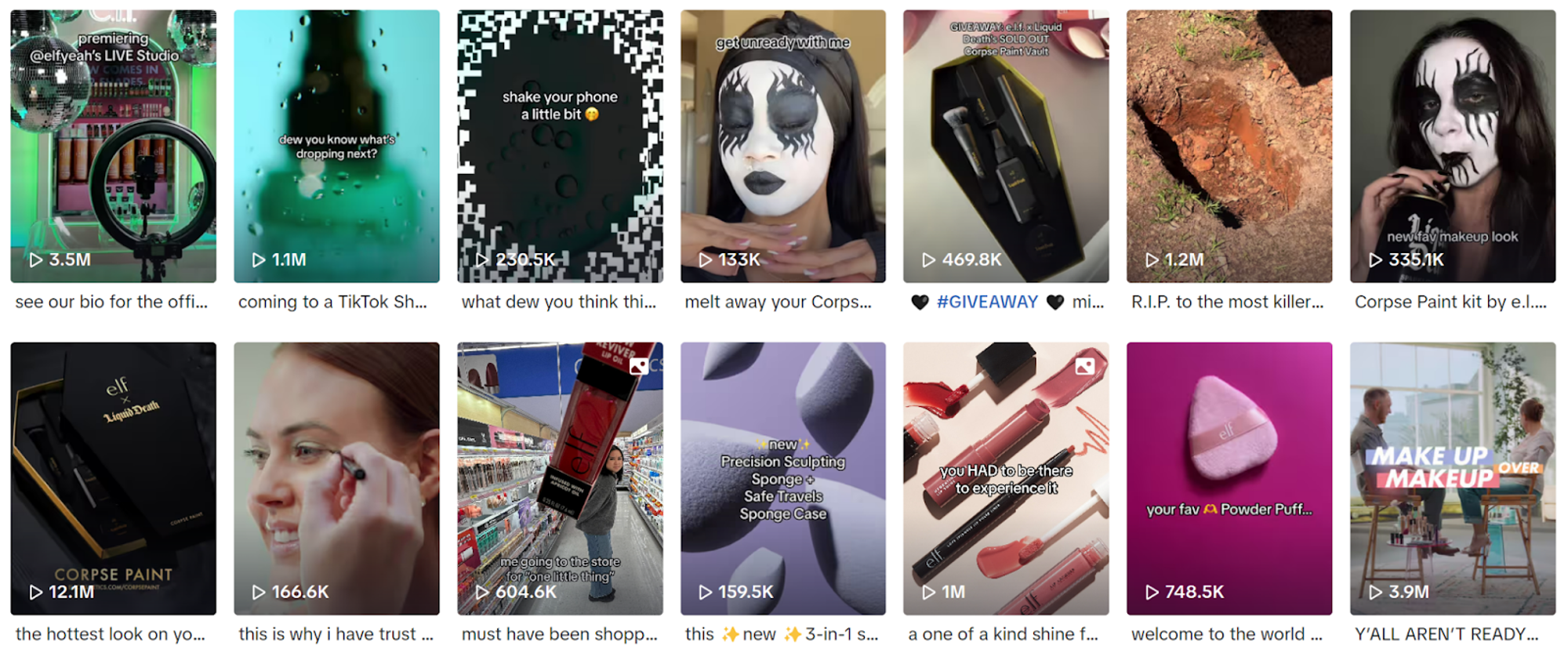
Strategy overview: Hashtag campaigns, influencer collabs, user-generated content
One of e.l.f Cosmetics' biggest TikTok win was its #eyeslipsface dance challenge. It commissioned a song based on its acronym and challenged platform users to dance to it. It was an instant hit, with individual posts collecting over 7 million views.
.png?width=2000&height=1044&name=image%20(58).png)
Soon, the brand moved on to influencer collaborations while leveraging shoppable videos and 'shop-the-look' reels to promote its products. One such partnership was with the American pop singer, Meghan Trainor.
@elfyeah shop Meghan's look in the TikTok shop 🛒 #elfcosmetics #eyeslipsface #eyeslipsfacts #elfcheck ♬ original sound - e.l.f. Cosmetics
e.l.f. Cosmetics also frequently relies on user-generated video content. More specifically, it uses reels, highlights, and other videos featuring its customers to push new hashtag campaigns.
The #makeupovermakeup challenge is the perfect example here. Couples record themselves applying makeup to their partner while talking about their lives.
@elfyeah this is why i have trust issues #elfcosmetics #makeupovermakeup #jimmyandchelsea ♬ original sound - e.l.f. Cosmetics
As eCommerce strategies go, all of this may not sound exciting. It has been done before. However, e.l.f. Cosmetics differentiates its attempt by prioritizing community building while leaning heavily on online shopping trends (influencer marketing, shoppable videos, etc.).
Case study 2: Ryanair’s lesson on audience engagement
Who they are
Ryanair is an Irish low-cost airline and the third-largest aircraft carrier in the EU. It has an annual passenger traffic of 70.67 million and a network of flights spanning Europe and North Africa.
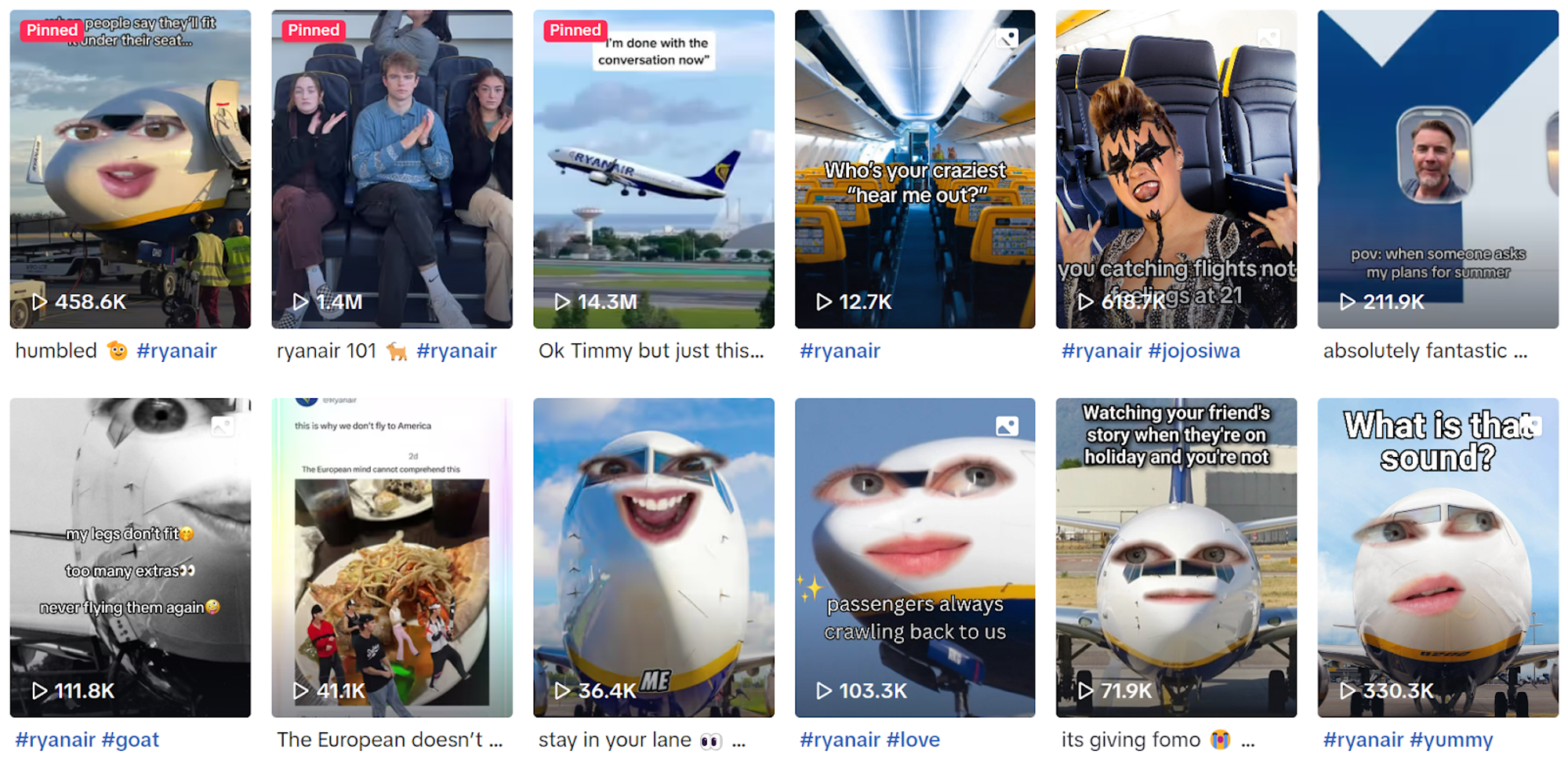
Strategy overview: Memes, trending bytes & user-generated content
The airline’s TikTok page is a masterclass in building audience interaction and consumer engagement. And it achieves this primarily by substituting ‘stiff professionalism’ with relatable (and sometimes controversial) humor.
Now, most of its content falls under two broad categories.
The first is a sassy media personality that builds on its brand image and unique value proposition—ultra cheap flights without any frills. The screenshot below is an excellent example of this.
@ryanair You ain't fooling anyone, shorty 🥴
♬ original sound - Saint
Ryanair also doesn’t shy away from publicizing its focus on passenger turnover. Here’s a post that demonstrates this perfectly.
@ryanair It's called 25 minute turn around for a reason #ryanair #bridgerton ♬ original sound - Abbie
The second category involves the brand leveraging ongoing trends to build audience relatability. For instance, one reel references Millie Bobby Brown’s Glamour interview for a funny bit that resonates especially well with Gen Z users.
@ryanair your phone goes on holidays before you do, milly #millybobybrown #ryanair #fyp ♬ original sound - Ryanair
The brand also incorporates user-generated content in its TikTok marketing strategy. Here’s a post from their passengers that the airline put their own spin on (read the caption).
@ryanair Please stop it or we'll charge. #proposal #ryanair #fyp ♬ original sound - Ryanair
Ryanair currently has 2.2 million followers, with roughly 38.6 million cumulative likes. The reason for its online popularity is simple. It understood its customers’ sensibilities and recognized content consumption trends on the platform.
The result? Better brand awareness and audience engagement without a large-scale digital branding campaign.
Case study 3: Gymshark’s neverending memes for the Gen Z crowd
Who they are
Gymshark is a UK-based eCommerce fitness apparel brand with a strong following on YouTube, Instagram and TikTok. Currently, Gymshark is available in 180 countries, generating over $600 million in sales annually.
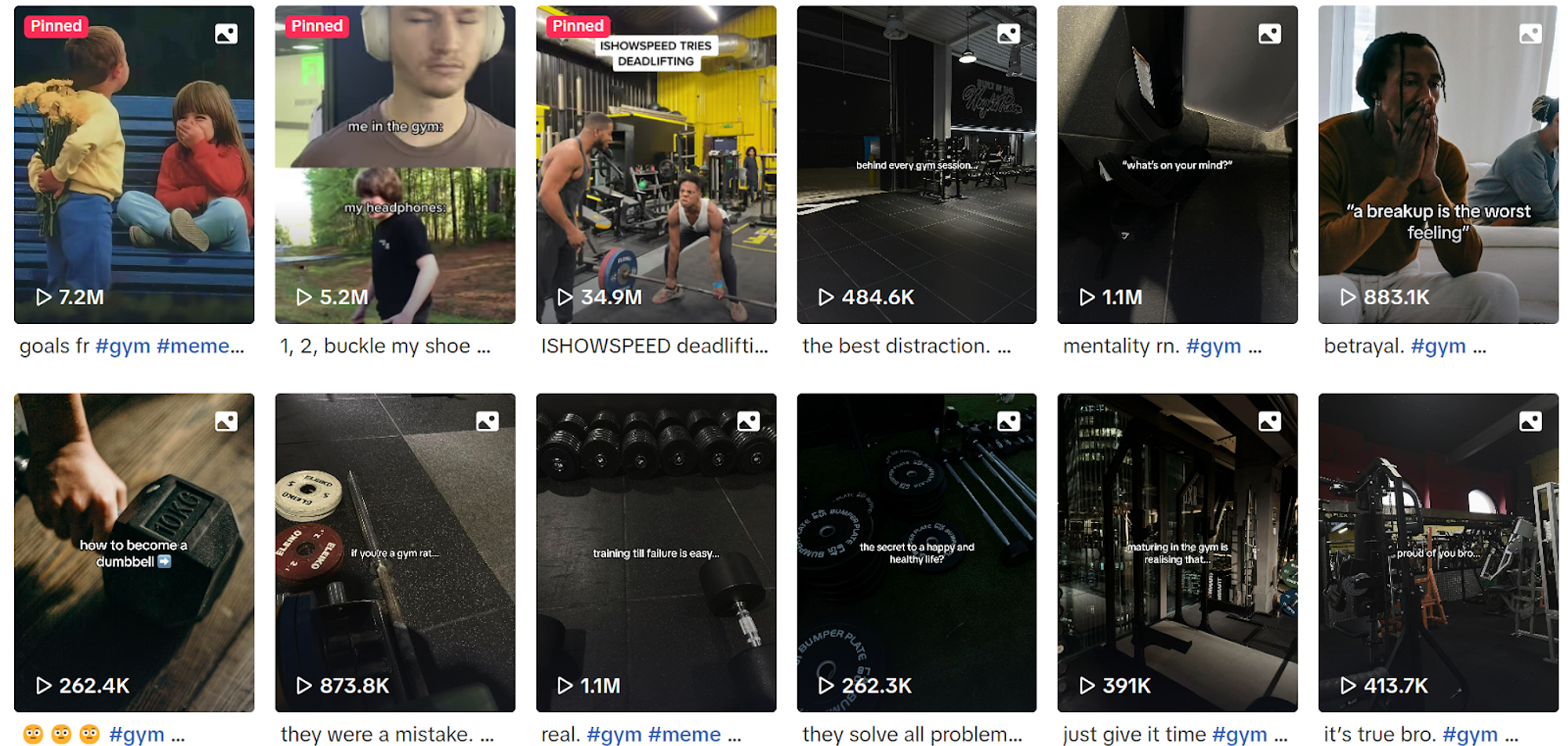
Strategy overview: Memes (without any rhyme or reason) & influencer collaborations
Most fitness-related content creation strategies focus on motivational posts, workout routines, tips, etc. Gymshark turned this on its head and based its video marketing plan exclusively on memes.
Here's the interesting bit: Most of these memes would make no sense to the older generation. But they are a riot with Gen Z users because the material/content itself plays on their sense of humor. Here's one example of this.
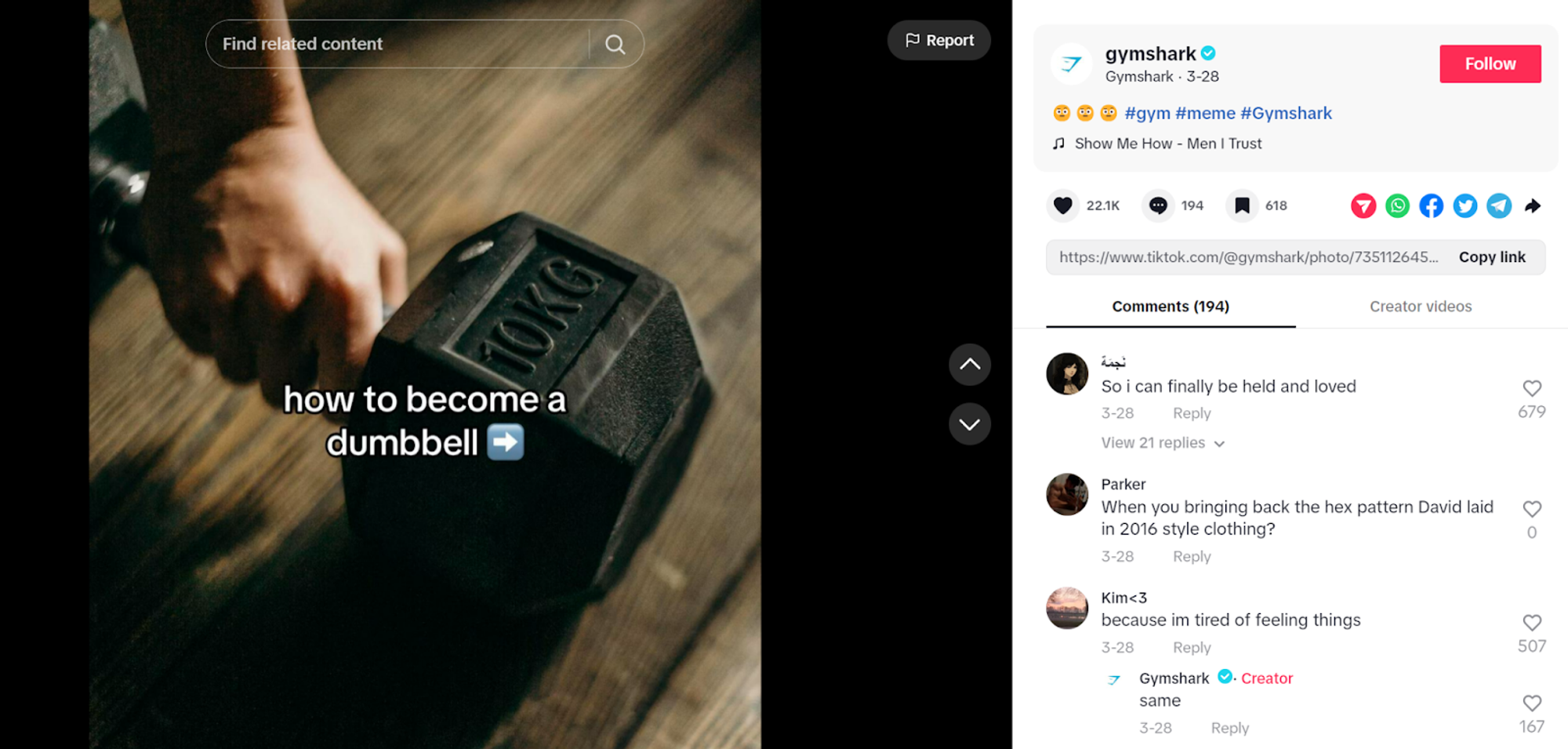
Another interesting bit is its partnership with IShowSpeed, a streamer and internet personality popular with millennials and Gen Zs. But it's not your typical influencer collaboration, where the celebrity/influencer comes on to promote a product.
Instead, it’s Gymshark playfully mocking IShowSpeed, something that the streamer’s audience also does frequently.
@gymshark ISHOWSPEED deadlifting #ishowspeed #ishowspeedclipz #Gymshark ♬ I Wanna Go Home - Fat Cat
All this is to say that Gymshark knows exactly what it's doing. It's not going for the 'tired' tactic of motivating its customers to hit the gym. It's building off chaotic, youthful energy to encourage consumer engagement and online audience interaction.
Case study 4: Duolingo’s ‘unhinged’ brand humanization tactic
Who they are
Duolingo is a language-learning app that offers over 40 courses. And with the increasing focus on digital delivery models in the ed-tech market, Duolingo has cemented itself as one of the industry frontrunners. Reports estimate that the brand could generate up to to $729.5 million in revenue in 2024.
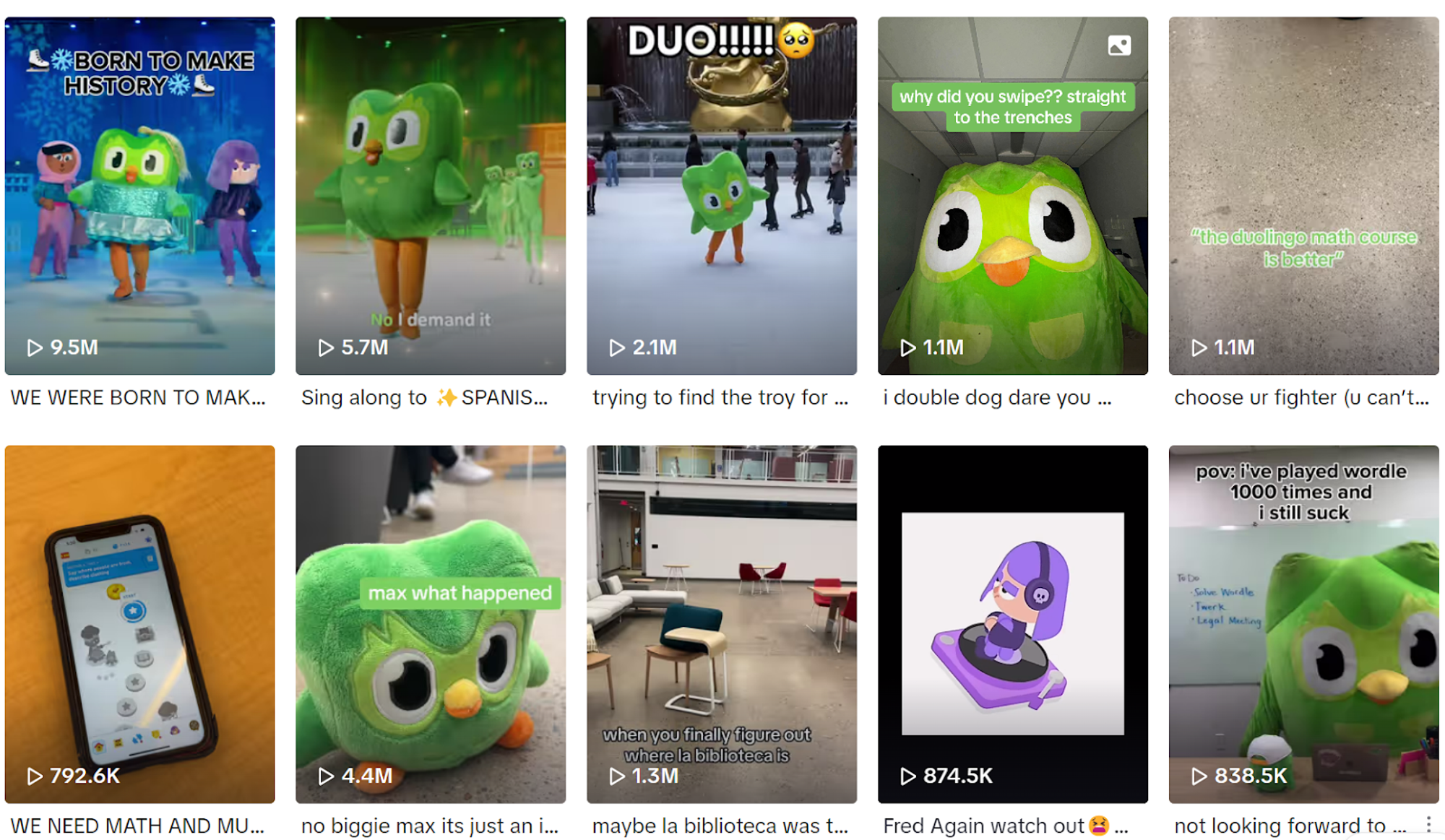
Strategy overview: #Mascottok, ‘internet humor’ & viral memes
Duolingo’s content creation strategy revolves around its mascot, Duo the owl. And Duo is not just a flimsy online persona—he is a complex (sometimes unhinged) character with a constant pulse on ‘internet humor’.
@duolingo sad g(owl) hours #duoplushie #duolingo #languagelearning #emo ♬ Rio romeo - .𝖒𝖊𝖓'🎧★
Even so, Duolingo doesn't always use its posts to push its app. Instead, most of its reels feature the mascot doing completely unrelated things. One example here would be where Duo meets other cartoon characters and mascots, including the Teletubbies.
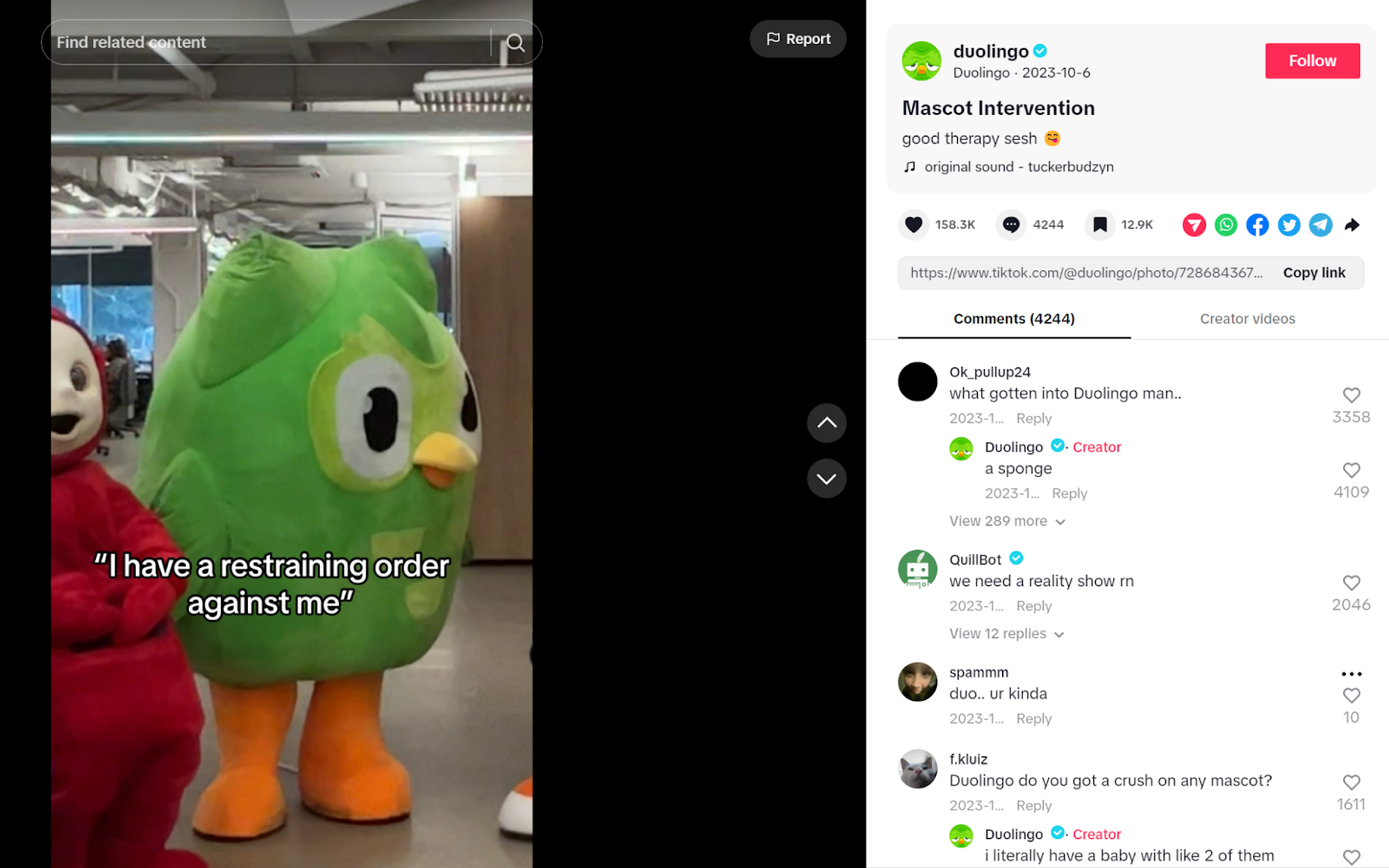
This may seem random, but there's a method to this madness. By using a mascot that behaves erratically, Duolingo puts the attention back on itself. And it does it in a manner that’s relatable to the younger generation (its target demographic).
In a recent interview, Zaria Parvez, the brand’s Global Social Media Manager, explains their approach to TikTok marketing.
To paraphrase, she says their entire purpose with Duo the owl was to just have a presence on the platform. The fact that they relied on ‘internet humor’ and built a personable character to associate their brand with only added to their popularity.
Saying that their strategy worked would be an understatement. Right now, Duolingo has 11.3 million followers on TikTok, with over 250 million likes.
Case study 5: Bliss’ impressive content catalog and adaptability
Who they are
Bliss is an American beauty and skincare brand with a commitment to cruelty-free and derma-tested products. Recently, the company was acquired by AS Beauty and became the first mass-produced skincare brand to receive a B-Corp certification.

Strategy overview: Product close-ups, skincare tips/hacks, creator integration
Bliss’ TikTok page is a prime example of why it’s crucial to diversify your content for better social media conversion and reach.
One of the brand’s earliest hits was the #ThisisBliss campaign to promote its ‘Clear Genius’ product line. It quickly hit over 6.7 billion views, with roughly 970,000 posts incorporating the hashtag.
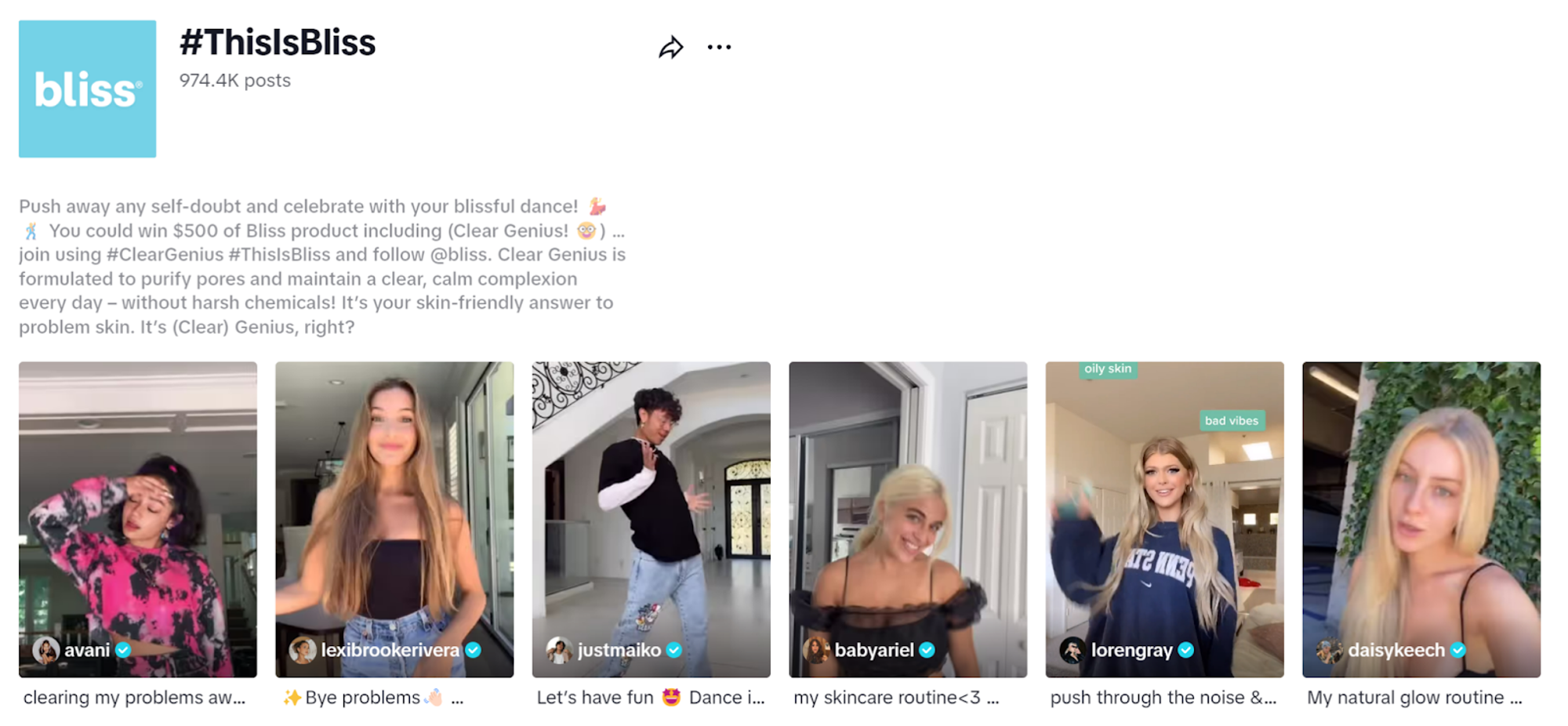
Another way Bliss gets the community involved in its TikTok marketing strategy is through skincare tips and hacks. It also brings in popular creators for such content formats. The brand's collaboration with Solielcrow is one example here.
@bliss 4 steps, including cleansing😍 @soleillcrow #realizations #skincareroutine #blissskincare #ThisIsBliss ♬ deja vu - favsoundds
Finally, Bliss uses pop culture references and throwbacks for its product close-ups. Here's a post where it relates its products with the cast from the 'Gilmore Girls'.
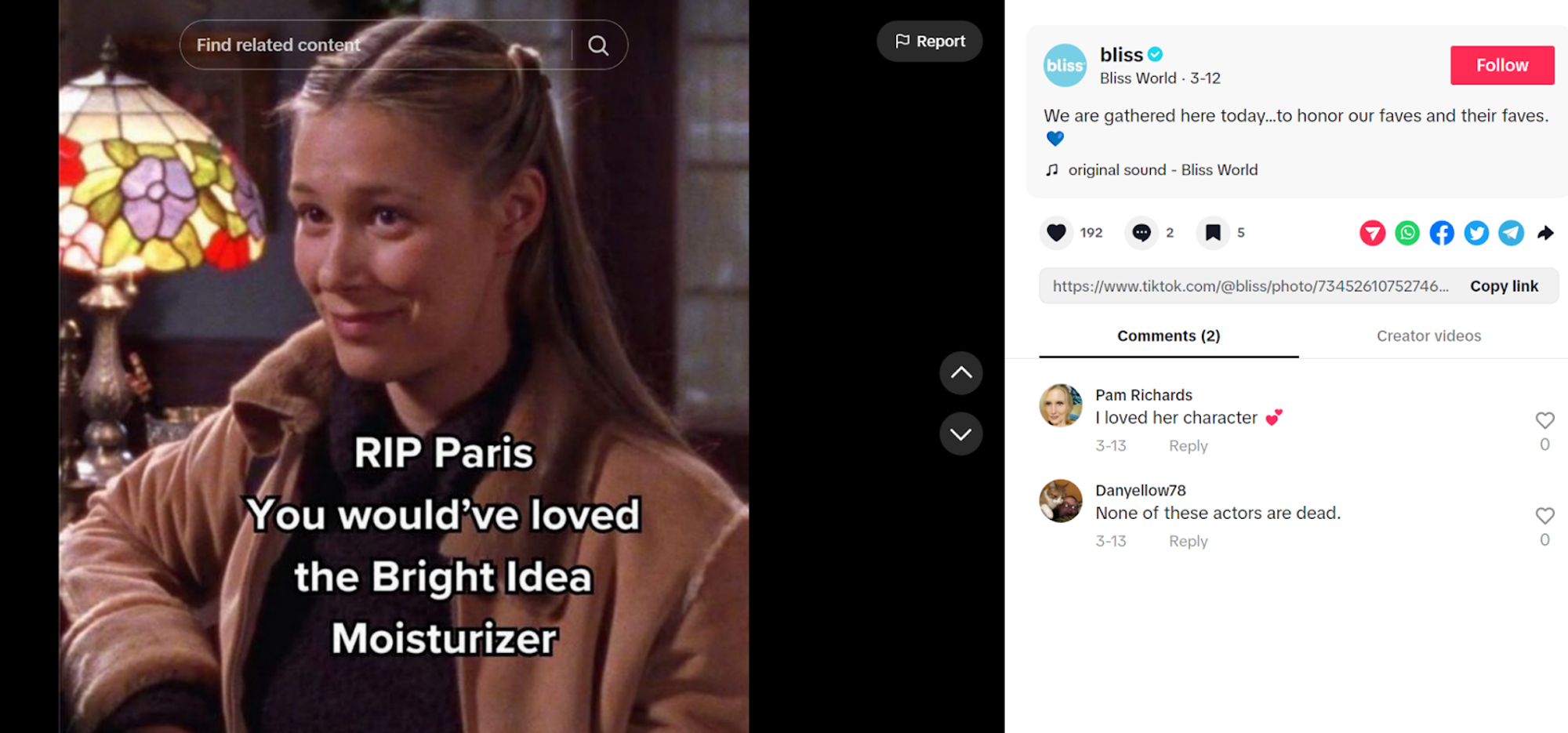
Bliss’ digital branding strategy is perhaps the most varied one in this list (aside from e.l.f cosmetics). It doesn’t restrict itself to a specific content type or format. Instead, it posts whatever works for the brand and, more importantly, feels authentic to its identity.
Ready to step up your TikTok marketing game?
TikTok marketing is here to stay. With all the emerging online shopping trends—shoppable videos, user-generated material, and video marketing content— it’d be a missed opportunity if you overlooked the app as a viable sales and promotional channel.
But don't just jump into it without a plan. Instead, find your niche, research what your audience likes, understand ongoing trends, and, then, go ham.
And, if you need more inspiration, check out how some of the top eCommerce brands leveraged TikTok content to build audience engagement and boost their sales.
Share

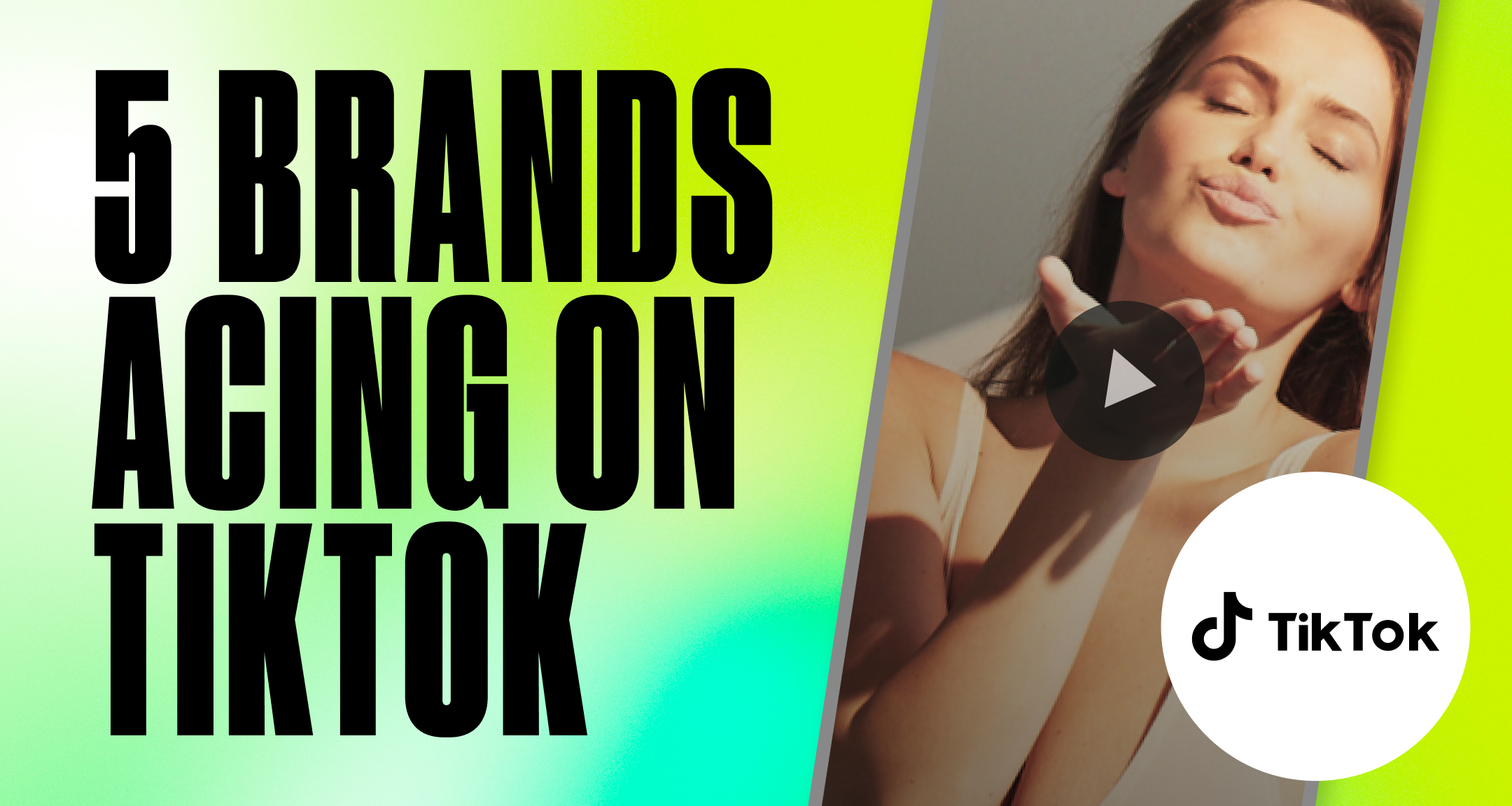


.jpg?width=420&height=420&name=live%20shopping%20top%205%20fashion%20(1).jpg)